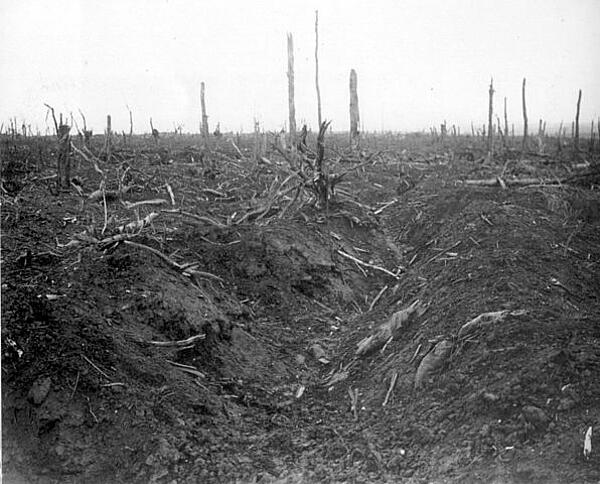Delville Wood
The fighting that took place at Delville Wood during World War One was incredibly brutal, leaving not a single tree in the woods untouched. It was known by many of the soldiers by the alternative name of ‘Devil’s Wood’.
The attack of Delville Wood was part of the Battle of the Somme, which took place in July 1916. The Somme was the famous plan of General Douglas Haig, who believed it would be the Allied nations’ final ‘Big Push’ that would end the war on the Western Front. With the exception of some of the attacks by the French, the assaults by Allied soldiers across the Somme were a failure.
The attack on Delville Wood took place to clear German forces who would have represented a threat to the Allied forces in the rear as they moved towards the enemy. However, the plan required the attack across the Somme battlefront to be successful.
The Delville Wood attack began on 15th July, when just over 3,000 men form the South African 1st Infantry Brigade were tasked with clear the wood “at all costs”. As with many other battles, the Allies used artillery bombardment to begin the assault before sending in the infantry. This resulted in the southern part of the woods begin quickly cleared of Germans, and positive news was reported back to headquarters.
However, the South Africans had actually placed themselves in a difficult position as they had come across 7,000 Germans who had easy access to them due to the shelling of the trees. The roots left after the artillery bombardment also made it almost impossible to dig trenches so they were given minimal protection against the Germans.
As a result of the situation that faced the South Africans, they were forced for the most part to engage in hand-to-hand combat and this led to a high number of casualties. This also made it difficult for them to retrieve the wounded, but the fighting was so fierce that for every one person wounded, four were killed. The South Africans continued to fight until 19th July when they were relieved, but in that time they suffered some of the worse casualties seen across the Western Front during the whole of the war.

The fight in Delville Wood was described by one soldier as follows:
“Every semblance of a trench seemed full of dead-sodden, squelchy, swollen bodies. Fortunately the blackening faces were invisible except when Verey lights lit up the indescribable scene. Not a tree stood whole in that wood.
Food and water were very short and we had not the faintest idea when any more would be obtainable.
We stood and lay on putrefying bodies and the wonder was that the disease (dysentery) did not finish off what the shells of the enemy had started.
There was hand-to-hand fighting with knives, bombs, and bayonets; cursing and brutality on both sides such as men can be responsible for when it is a question of "your life or mine"; mud and filthy stench; dysentery and unattended wounds; shortage of food and water and ammunition.”
Captain S. J. Worsley, MC
A German soldier also described his experienced:
“Delville Wood had disintegrated into a shattered wasteland of shattered trees, charred and burning stumps, craters thick with mud and blood, and corpses, corpses everywhere. In places they were piled four deep.”
In response to the attack by the Allies, the Germans decided to shell the areas that had been captured, and it is believed that at one point there were 400 shells landing in Delville Wood every minute. The addition of severe rain meant the wood soon became boggy and impassable, making battle almost impossible for the infantrymen.
The battle continued until August, with skilfully placed machine guns and snipers machine it hard for the Allies to make any progress. Once the South Africans were relieved, men from the Royal Welsh Fusiliers, the Royal Berkshires and the 1st King’s Royal Rifle Corps tried to take the wood. However, they were faced with a heavily fortified enemy that was supported by very accurate artillery fire. They in turn were relieved and replaced by the 17th Northern Division who were relived by the 14th and 20th Light Division.
Delville Wood was only fully cleared of Germans on 3rd September but Germans then recaptured it in March 1918 as part of their Spring Offensive. Thankfully, it was there retaken once more by the 38th Welsh Infantry Division in August 1918.
Historians believe that German casualties matched Allied casualties but as with many battles this is difficult to verify. The South Africans lost 80 per cent of their men - 2,536 casualties - as well as 104 officers. However, four Victoria Crosses were awarded following the battle.
MLA Citation/Reference
"Delville Wood". HistoryLearning.com. 2025. Web.
